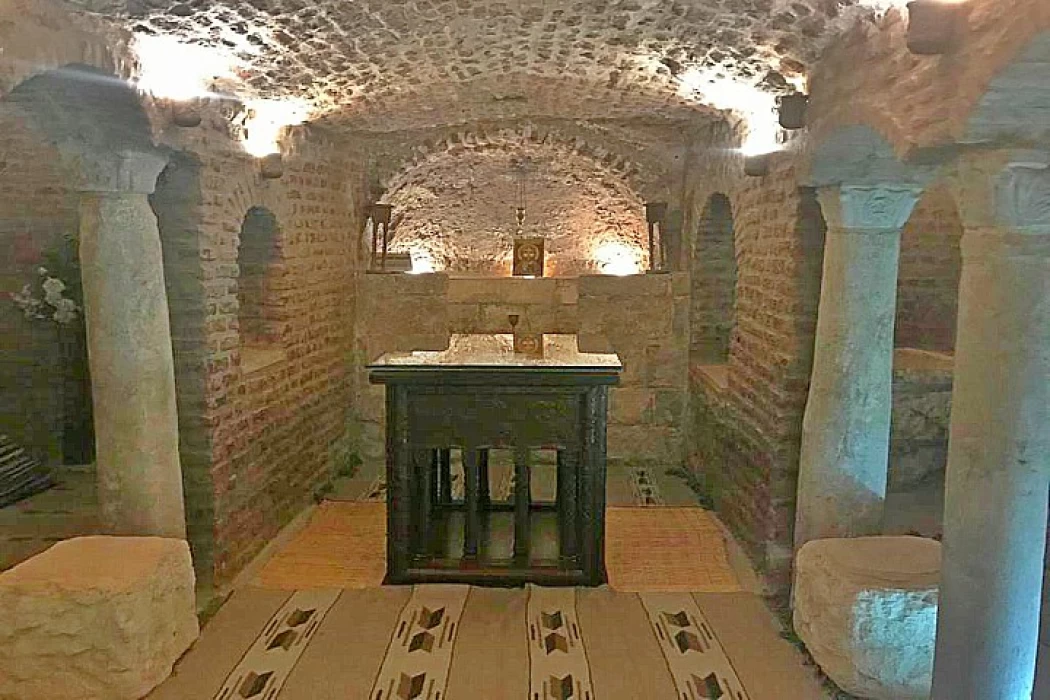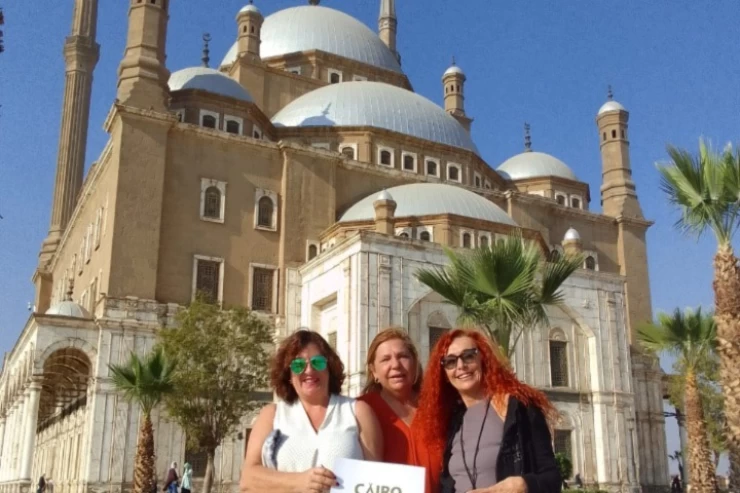
The Holy Family route in Egypt | The Footsteps of Jesus in Egypt
The Holy Family route in Egypt
In the year 1 BC, Gabriel, the angel of the Lord, appeared to a fiancée, betrothed, whose name was Mary, to preach to her the birth of a son named Jesus.
Of course, the angel realized that her fiancé, Youssef El-Naggar, would be suspicious of this issue, so he also appeared and assured him.
It was clear that the sky was busy with this birth. With these two, a vision appeared for three kings from Persia and foretold them of the news; an angel appeared to one of the rabbis of the Jews and preached the birth of his son named John the Baptist, and he foretold that this would be a sign of the birth of Jesus.
The Footsteps of Jesus in Egypt
The Torah was full of ancient prophecies talking about the details of this birth, its location, what the kings will give this child, and his journey to the land of Egypt, as well as the madness of the king who will lead to this journey.
The family did not settle in one place, so there are many monasteries and churches, and this is documented through religious sources and rare manuscripts in Coptic monasteries and churches in Egypt, adding: “The trip ranged from a week or a few days in some cities, and in others, it settled a month and the longest period in Qasqam Mountain Who is in the city of Assiut now and spanned 185 days.
After God commanded the Virgin to escape her newborn from the oppression of Herod heading to Egypt, there were 3 known commercial and war routes that a traveler could take at that time,
avoiding the known methods and choosing unknown paths, and the journey that split into three stages began
They crossed the Nile to the west at Desouk and headed south to Beheira Governorate until they reached Tarana near Khattabah, then Wadi El Natrun in the wilderness of Shihit, where 500 monasteries were built there,
including four of them Saint Abu Makar, Anba Bishoy, Alsaryan, and Braamos, then they crossed the Nile south until they reached the charitable barrages.
Then the march included a direction to Al-Matariyah and Ain Shams, which was inhabited by 2000 Jews the family rested under a sycamore tree and there witnessed a miracle that Christ took the stick on which Joseph the carpenter leaned and broke it into pieces and then planted and put his hand on the ground so the water spring and the balsam extracted from which balsam oil is extracted It has a smart smell, and the remains of the well and the tree are still there inside an open museum called the Mary Tree Museum,
and there are the remains of the tree and have names for the soldiers of the French expedition who registered it after recovering from purulent ophthalmia, after washing their face from the water of the well, and also there is the provider in which Christ was washed
.
Then the family headed to the Zewaila Gate and The Hanging Church with water well, then they went to the ancient Roman fortress of Babylon where the archaeological Church of Abu Serga known as the two martyrs Sergius and Wajis, then installed the Nile complex for Maadi where the Church of the Virgin is now.
The journey lasted two years, six months, and ten days, and the family returned from Qusiya to Maadi, then to the Babylon Fortress, where a cave was located at the bottom of the Abu Sergius Church, then north to Musturod, then to Belbis, then Qantara, then to Palestine, via Gaza, and finally settled in Nazareth. Churches, and considered tourist attractions.
How did the Holy Family travel to Egypt?
The Holy Family traveled from Bethlehem to Gaza to the Zaraniq (Falsiyat) reserve, 37 km west of Al-Arish, and entered Egypt via the northern side of Al-Farma (Balusium), located between the cities of Al-Arish and Port Said.
How many years did jesus live in egypt?
The precise amount of time the Holy Family stayed in Egypt has been disputed by historians, but Coptic tradition describes it as more than three years and just under four years.
The Journey of the Holy Family to Egypt Pope Theophilus, the 23rd Patriarch of Alexandria (385–412), decided his decree during the Ninth Coptic Week of 1999 that "the journey from leaving Bethlehem until returning to Nazareth is three years and six months, which is consistent with the estimate that the Holy Family will remain in Egypt for nearly two years, and the rest has departed on the journey of coming and returning."
In the year 1 BC, Gabriel, the angel of the Lord, appeared to a fiancée, betrothed, whose name was Mary, to preach to her the birth of a son named Jesus.
Of course, the angel realized that her fiancé, Youssef El-Naggar, would be suspicious of this issue, so he also appeared and assured him.
It was clear that the sky was busy with this birth. With these two, a vision appeared for three kings from Persia and foretold them of the news; an angel appeared to one of the rabbis of the Jews and preached the birth of his son named John the Baptist, and he foretold that this would be a sign of the birth of Jesus.
The Torah was full of ancient prophecies talking about the details of this birth, its location, what the kings will give this child, and his journey to the land of Egypt, as well as the madness of the king who will lead to this journey.
The family did not settle in one place, so there are many monasteries and churches, and this is documented through religious sources and rare manuscripts in Coptic monasteries and churches in Egypt, adding: “The trip ranged from a week or a few days in some cities, and in others, it settled a month and the longest period in Qasqam Mountain Who is in the city of Assiut now and spanned 185 days.
After God commanded the Virgin to escape her newborn from the oppression of Herod, heading to Egypt, there were 3 known commercial and war routes that a traveler could take at that time, avoiding the known methods and choosing unknown paths, and the journey that split into three stages.
They crossed the Nile to the west at Desouk and headed south to Beheira Governorate until they reached Tarana near Khattabah, then Wadi El Natrun in the wilderness of Shihit, where 500 monasteries were built, including four of them, Saint Abu Makar, Anba Bishoy, Alsaryan, and Braamos, they crossed the Nile south until they reached the charitable barrages.
Then the march included a direction to Al-Matariyah and Ain Shams, which was inhabited by 2000 Jews the family rested under a sycamore tree and there witnessed a miracle that Christ took the stick on which Joseph the carpenter leaned and broke it into pieces and then planted and put his hand on the ground so the water spring and the balsam extracted from which balsam oil is extracted It has a smart smell, and the remains of the well and the tree are still there inside an open museum called the Mary Tree Museum,
and there are the remains of the tree and have names for the soldiers of the French expedition who registered it after recovering from purulent ophthalmia, after washing their face from the water of the well, and also there is the provider in which Christ was washed.
Then the family headed to the Zewaila Gate and the Hanging Church with a water well, then they went to the ancient Roman fortress of Babylon, where the archaeological Church of Abu Serga, known as the two martyrs Sergius and Wajis, then installed the Nile complex for Maadi, where the Church of the Virgin is now.
The journey lasted two years, six months, and ten days, and the family returned from Qusiya to Maadi, then to the Babylon Fortress, where a cave was located at the bottom of the Abu Sergius Church, then north to Musturod, then to Belbis, then Qantara, then to Palestine, via Gaza, and finally settled in Nazareth. Churches, and considered tourist attractions.
The Church of Abu Serga is one of the important stations where the Holy Family settled in the Babylon Fortress, after taking refuge in Egypt to escape the oppression of the Roman ruler in Palestine.
Historians confirm that it is the oldest church in ancient Egypt, and indeed in all of Cairo. The Holy Family passed through the same location where it was constructed. The grotto where the Holy Family slept during their flight to Egypt is located there.
Holy Family Church in Matariya: The Holy Family took the road east of the Nile, and Herod's soldiers came from west of the Nile and came to Matariya while leaving Egypt and not while entering... In the church, there is an amazing statue representing the size of Jesus Christ. When he was in the Matariya area, he was five years old.
The Holy Family traveled from Bethlehem to Gaza to the Zaraniq (Falsiyat) reserve, 37 km west of Al-Arish, and entered Egypt via the northern side of Al-Farma (Balusium), located between the cities of Al-Arish and Port Said.
The precise amount of time the Holy Family stayed in Egypt has been disputed by historians, but Coptic tradition describes it as more than three years and just under four years.
The Journey of the Holy Family to Egypt Pope Theophilus, the 23rd Patriarch of Alexandria (385–412), decided his decree during the Ninth Coptic Week of 1999 that "the journey from leaving Bethlehem until returning to Nazareth is three years and six months, which is consistent with the estimate that the Holy Family will remain in Egypt for nearly two years, and the rest has departed on the journey of coming and returning."















